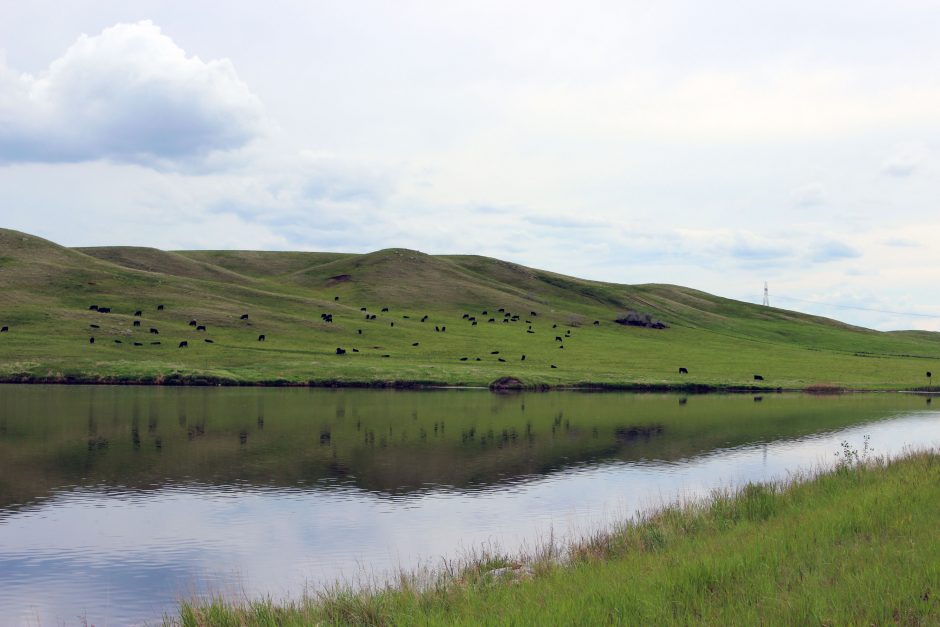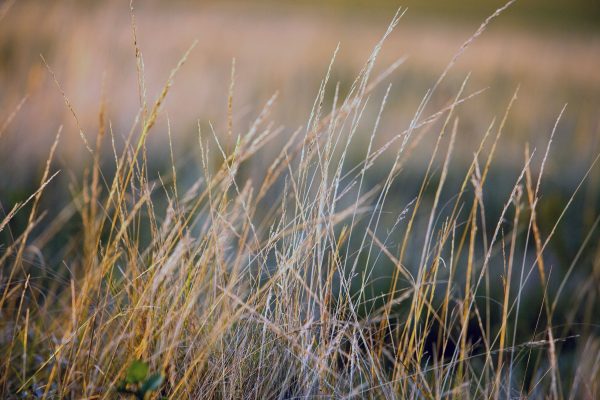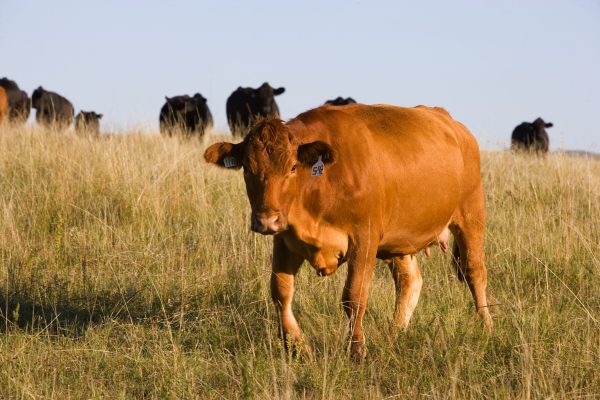Northern Plains Livestock Producers Still Feeling 2017 Drought

Black Angus cattle graze on green slopes in native prairie pasture along Highway 13 between Lehr and Wishek, ND. (Credit: By USFWS Mountain-Prairie [CC BY 2.0 (https://creativecommons.org/licenses/by/2.0) or Public domain], via Wikimedia Commons.)
Beginning in spring of 2017, drought conditions descended upon the Northern Plains region of the United States, causing Montana, South Dakota, and North Dakota livestock producers to experience reduced production, stock losses, and even property destruction as wildfires ripped across the plains. Part of the North Dakota State University Extension, livestock environmental stewardship specialist Miranda Meehan’s work is reaching out to producers to help them mitigate ongoing losses from the drought.
According to Dr. Meehan, the 2017 drought was the most widespread drought since 2006, impacting more than 99 percent of the state during the growing season. At the drought’s peak, 8 percent of the state reached the D4 (Exceptional Drought) category. In some areas, conditions were worse than those created by the 1988 drought, a notably dry five-year period in the state.
“The primary impacts livestock producers experienced was decreased forage production, decrease in forage quality, shortages of water, and compromised water quality,” explains Dr. Meehan. “The decline in forage production was directly related to low precipitation during the growing season. This was not only felt during the grazing period but also over the winter months as hay supplies were lower, causing many producers to purchase hay. The shortage in the available hay was further compounded by a late spring, which delayed pasture turnout.”
Many farmers harvested failed crops as hay for livestock because of the drought. Unfortunately, drought-stressed crops and forages can accumulate nitrates, which can cause nitrate poisoning in ruminant livestock. High nitrate levels cause accumulation and eventual absorption by red blood cells. This, in turn, means reduced oxygen transportability.
“Their digestive process converts nitrate to nitrite, which in turn is converted to ammonia,” details Dr. Meehan. “Some producers did lose animals to nitrate poisoning, and/or see an increase in occurrence of abortions in pregnant females.”
Predictably, the drought also affected surface water availability. This has forced producers to haul water or install an alternative water source such as a well or pipeline. In response to the water shortage, North Dakota State Water Commission opened the Drought Disaster Livestock Water Supply Program, which will cover up $3,500 of the eligible costs for water development projects.

Native Rangeland Grazing System, grassland used for grazing in North Dakota. (Credit: Scott Bauer / Photo courtesy of USDA Natural Resources Conservation Service)
“As water sources became depleted, the concentrations of total dissolved solids (TDS) and sulfates increased,” Dr. Meehan describes. “In addition to the increase in TDS, we saw an increase in cyanobacteria resulting from a combination of elevated nutrient levels and hot, dry weather that support the growth of the bacteria. Some species of cyanobacteria are toxic to animals, and some producers did lose animals to cyanobacteria poisoning.”
The drought still lingers, and recovery hasn’t been sufficient.
“Currently nearly 90% of the state is experiencing some level of drought according to the US Drought Monitor,” states Dr. Meehan. “To date [mid-May 2018] we have received little rain, and this is concerning as May and June’s rains dictate 80 percent of grass growth in North Dakota.”
Livestock feeling the effects
For many producers, the drought has meant finding a new water source. Numerous dugouts and ponds dried up thanks to the drought, and any remaining water is of suspect quality.
According to Dr. Meehan, the water source used by a rancher depends on the resources available; they use a variety of methods to provide water including ponds, dugouts, wells and pipeline. Some producers haul their water, although this is less common.
In fact, livestock drinking primarily from ponds and dugouts have a greater risk of contracting illnesses such as cyanobacterial poisoning, Giardia, and leptospirosis, than do trough drinkers.
“We do encourage producers to install wells and/or pipelines, as they provide better quality water, which improves livestock health and production,” remarks Dr. Meehan.
Research reveals that water quality directly impacts how much forage the livestock consume. In fact, Dr. Meehan points out, good-quality water leads to improved gains of as much as 0.24 pound per day for yearlings and 0.33 pound per day for calves.

Native Rangeland Grazing System, a grazing animal. (Credit: Scott Bauer / Photo courtesy of USDA Natural Resources Conservation Service)
While the biggest risks from the water right now are elevated levels of TDS and sulfates, livestock producers must monitor water continuously throughout the season—particularly a dry season like this one.
“The quality of water fluctuates throughout the season depending on the quantity of the water, which goes back to the old saying, ‘dilution is the solution to pollution,’” states Dr. Meehan. “The more water that is in the pond or dugout the less concentrated the mineral component in the water. Also, as we move into the heat of summer there is an increased risk for cyanobacteria, which can cause death within minutes of consumption.”
NDSU’s Veterinary Diagnostic Laboratory recommends that livestock producers test their water sources for TDS (including salts), nitrates, and sulfates. TDS levels should be less than 5,000 parts per million (ppm) in most cases since higher levels can harm grazing livestock. Sulfate levels should be less than 500 ppm for calves and less than 1,000 ppm for adults.
To enable producers to test, the NDSU lab provides their Livestock Water Testing Guidelines. These instruct producers on how to collect samples, and how to get them to the NDSU lab for analysis. The cost of a standard water quality test at the lab is approximately $25. The NDSU lab is also available for questions about livestock disease caused by poor water quality.
“The veterinary diagnostic lab can test for many components,” clarifies Dr. Meehan. “We recommend producers complete the basic water screen tests for nitrates, pH, TDS and sulfates. The lab can also conduct tests to see if a cyanobacteria bloom contains bacteria that are toxic.”
“Water is one of the most important nutrients for livestock, making it critical that they have an adequate supply of good quality water,” adds Dr. Meehan.
Top image: Black Angus cattle graze on green slopes in native prairie pasture along Highway 13 between Lehr and Wishek, ND. (Credit: By USFWS Mountain-Prairie [CC BY 2.0 (https://creativecommons.org/licenses/by/2.0) or Public domain], via Wikimedia Commons)




0 comments